CHEVROLET COBALT 2008 1.G Owners Manual
Manufacturer: CHEVROLET, Model Year: 2008, Model line: COBALT, Model: CHEVROLET COBALT 2008 1.GPages: 402, PDF Size: 2.15 MB
Page 261 of 402
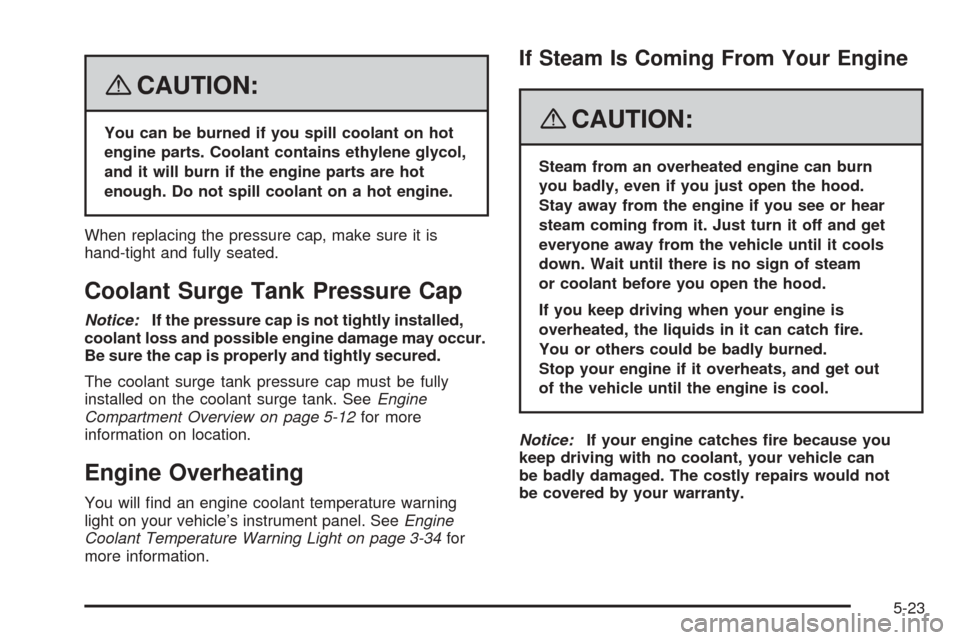
{CAUTION:
You can be burned if you spill coolant on hot
engine parts. Coolant contains ethylene glycol,
and it will burn if the engine parts are hot
enough. Do not spill coolant on a hot engine.
When replacing the pressure cap, make sure it is
hand-tight and fully seated.
Coolant Surge Tank Pressure Cap
Notice:If the pressure cap is not tightly installed,
coolant loss and possible engine damage may occur.
Be sure the cap is properly and tightly secured.
The coolant surge tank pressure cap must be fully
installed on the coolant surge tank. SeeEngine
Compartment Overview on page 5-12for more
information on location.
Engine Overheating
You will �nd an engine coolant temperature warning
light on your vehicle’s instrument panel. SeeEngine
Coolant Temperature Warning Light on page 3-34for
more information.
If Steam Is Coming From Your Engine
{CAUTION:
Steam from an overheated engine can burn
you badly, even if you just open the hood.
Stay away from the engine if you see or hear
steam coming from it. Just turn it off and get
everyone away from the vehicle until it cools
down. Wait until there is no sign of steam
or coolant before you open the hood.
If you keep driving when your engine is
overheated, the liquids in it can catch �re.
You or others could be badly burned.
Stop your engine if it overheats, and get out
of the vehicle until the engine is cool.
Notice:If your engine catches �re because you
keep driving with no coolant, your vehicle can
be badly damaged. The costly repairs would not
be covered by your warranty.
5-23
Page 262 of 402
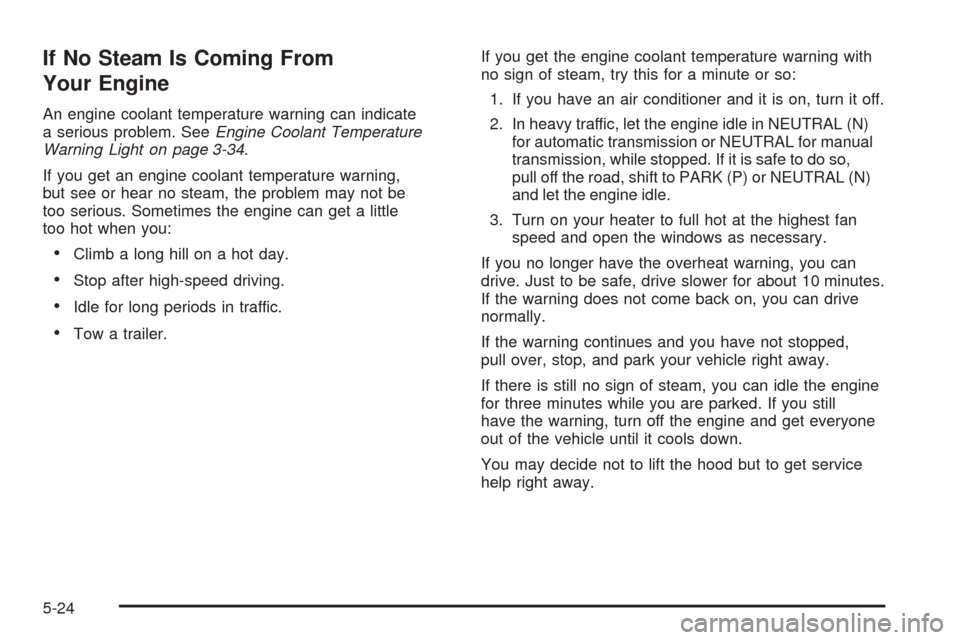
If No Steam Is Coming From
Your Engine
An engine coolant temperature warning can indicate
a serious problem. SeeEngine Coolant Temperature
Warning Light on page 3-34.
If you get an engine coolant temperature warning,
but see or hear no steam, the problem may not be
too serious. Sometimes the engine can get a little
too hot when you:
Climb a long hill on a hot day.
Stop after high-speed driving.
Idle for long periods in traffic.
Tow a trailer.If you get the engine coolant temperature warning with
no sign of steam, try this for a minute or so:
1. If you have an air conditioner and it is on, turn it off.
2. In heavy traffic, let the engine idle in NEUTRAL (N)
for automatic transmission or NEUTRAL for manual
transmission, while stopped. If it is safe to do so,
pull off the road, shift to PARK (P) or NEUTRAL (N)
and let the engine idle.
3. Turn on your heater to full hot at the highest fan
speed and open the windows as necessary.
If you no longer have the overheat warning, you can
drive. Just to be safe, drive slower for about 10 minutes.
If the warning does not come back on, you can drive
normally.
If the warning continues and you have not stopped,
pull over, stop, and park your vehicle right away.
If there is still no sign of steam, you can idle the engine
for three minutes while you are parked. If you still
have the warning, turn off the engine and get everyone
out of the vehicle until it cools down.
You may decide not to lift the hood but to get service
help right away.
5-24
Page 263 of 402
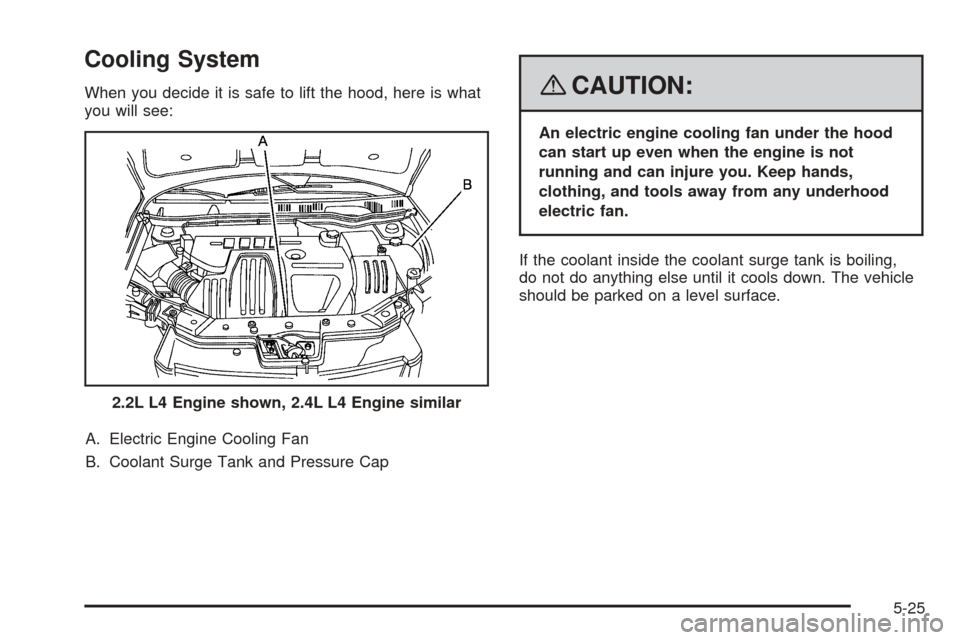
Cooling System
When you decide it is safe to lift the hood, here is what
you will see:
A. Electric Engine Cooling Fan
B. Coolant Surge Tank and Pressure Cap{CAUTION:
An electric engine cooling fan under the hood
can start up even when the engine is not
running and can injure you. Keep hands,
clothing, and tools away from any underhood
electric fan.
If the coolant inside the coolant surge tank is boiling,
do not do anything else until it cools down. The vehicle
should be parked on a level surface.
2.2L L4 Engine shown, 2.4L L4 Engine similar
5-25
Page 264 of 402
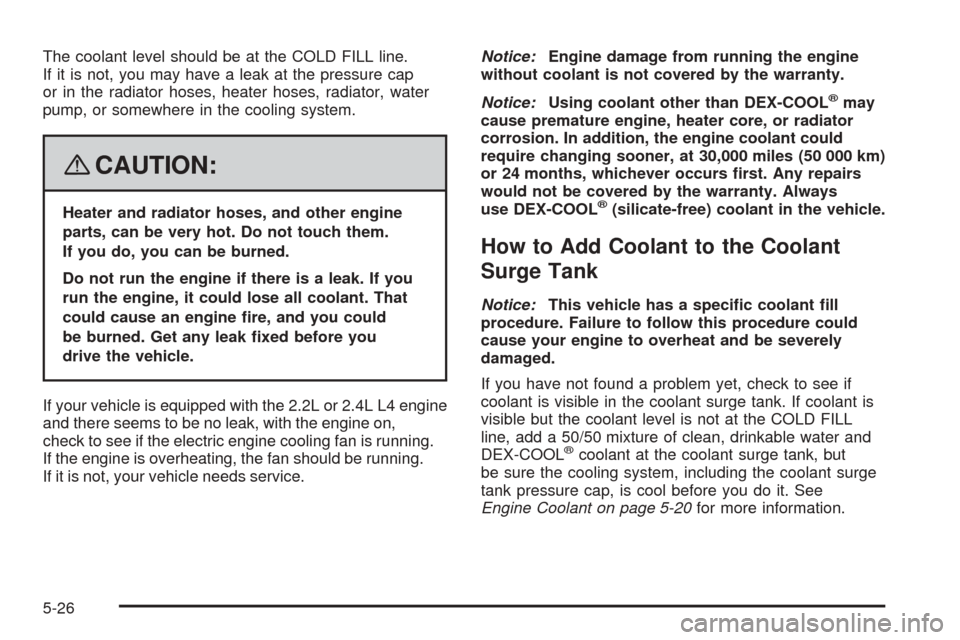
The coolant level should be at the COLD FILL line.
If it is not, you may have a leak at the pressure cap
or in the radiator hoses, heater hoses, radiator, water
pump, or somewhere in the cooling system.
{CAUTION:
Heater and radiator hoses, and other engine
parts, can be very hot. Do not touch them.
If you do, you can be burned.
Do not run the engine if there is a leak. If you
run the engine, it could lose all coolant. That
could cause an engine �re, and you could
be burned. Get any leak �xed before you
drive the vehicle.
If your vehicle is equipped with the 2.2L or 2.4L L4 engine
and there seems to be no leak, with the engine on,
check to see if the electric engine cooling fan is running.
If the engine is overheating, the fan should be running.
If it is not, your vehicle needs service.Notice:Engine damage from running the engine
without coolant is not covered by the warranty.
Notice:Using coolant other than DEX-COOL
®may
cause premature engine, heater core, or radiator
corrosion. In addition, the engine coolant could
require changing sooner, at 30,000 miles (50 000 km)
or 24 months, whichever occurs �rst. Any repairs
would not be covered by the warranty. Always
use DEX-COOL
®(silicate-free) coolant in the vehicle.
How to Add Coolant to the Coolant
Surge Tank
Notice:This vehicle has a speci�c coolant �ll
procedure. Failure to follow this procedure could
cause your engine to overheat and be severely
damaged.
If you have not found a problem yet, check to see if
coolant is visible in the coolant surge tank. If coolant is
visible but the coolant level is not at the COLD FILL
line, add a 50/50 mixture of clean, drinkable water and
DEX-COOL
®coolant at the coolant surge tank, but
be sure the cooling system, including the coolant surge
tank pressure cap, is cool before you do it. See
Engine Coolant on page 5-20for more information.
5-26
Page 265 of 402
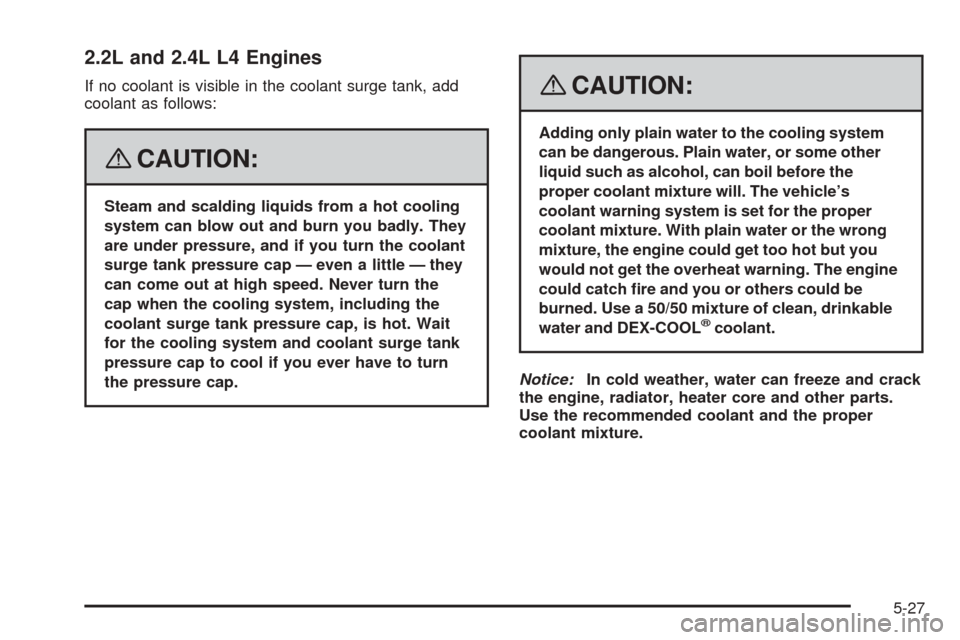
2.2L and 2.4L L4 Engines
If no coolant is visible in the coolant surge tank, add
coolant as follows:
{CAUTION:
Steam and scalding liquids from a hot cooling
system can blow out and burn you badly. They
are under pressure, and if you turn the coolant
surge tank pressure cap — even a little — they
can come out at high speed. Never turn the
cap when the cooling system, including the
coolant surge tank pressure cap, is hot. Wait
for the cooling system and coolant surge tank
pressure cap to cool if you ever have to turn
the pressure cap.
{CAUTION:
Adding only plain water to the cooling system
can be dangerous. Plain water, or some other
liquid such as alcohol, can boil before the
proper coolant mixture will. The vehicle’s
coolant warning system is set for the proper
coolant mixture. With plain water or the wrong
mixture, the engine could get too hot but you
would not get the overheat warning. The engine
could catch �re and you or others could be
burned. Use a 50/50 mixture of clean, drinkable
water and DEX-COOL
®coolant.
Notice:In cold weather, water can freeze and crack
the engine, radiator, heater core and other parts.
Use the recommended coolant and the proper
coolant mixture.
5-27
Page 266 of 402
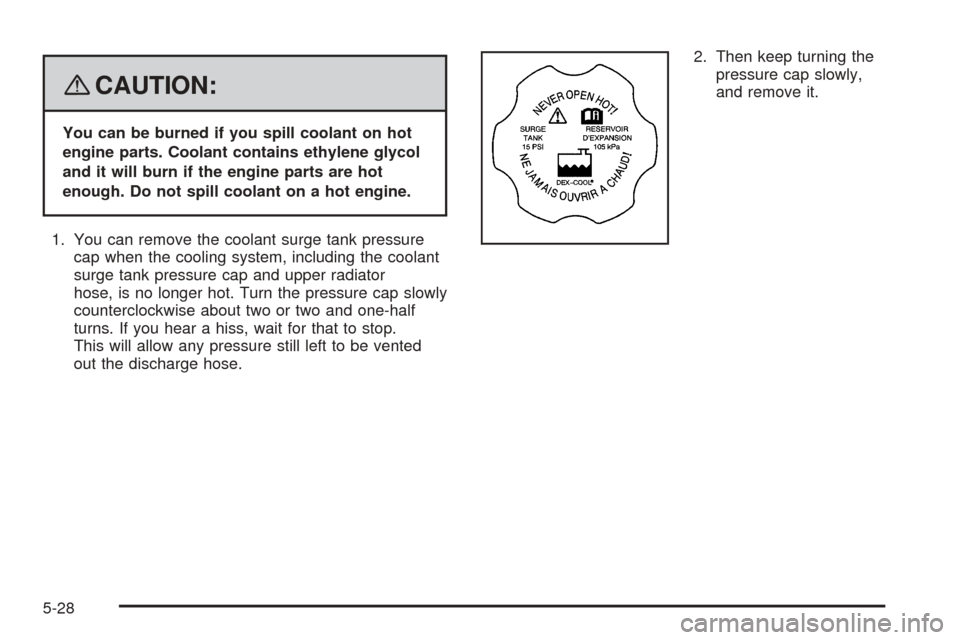
{CAUTION:
You can be burned if you spill coolant on hot
engine parts. Coolant contains ethylene glycol
and it will burn if the engine parts are hot
enough. Do not spill coolant on a hot engine.
1. You can remove the coolant surge tank pressure
cap when the cooling system, including the coolant
surge tank pressure cap and upper radiator
hose, is no longer hot. Turn the pressure cap slowly
counterclockwise about two or two and one-half
turns. If you hear a hiss, wait for that to stop.
This will allow any pressure still left to be vented
out the discharge hose.2. Then keep turning the
pressure cap slowly,
and remove it.
5-28
Page 267 of 402
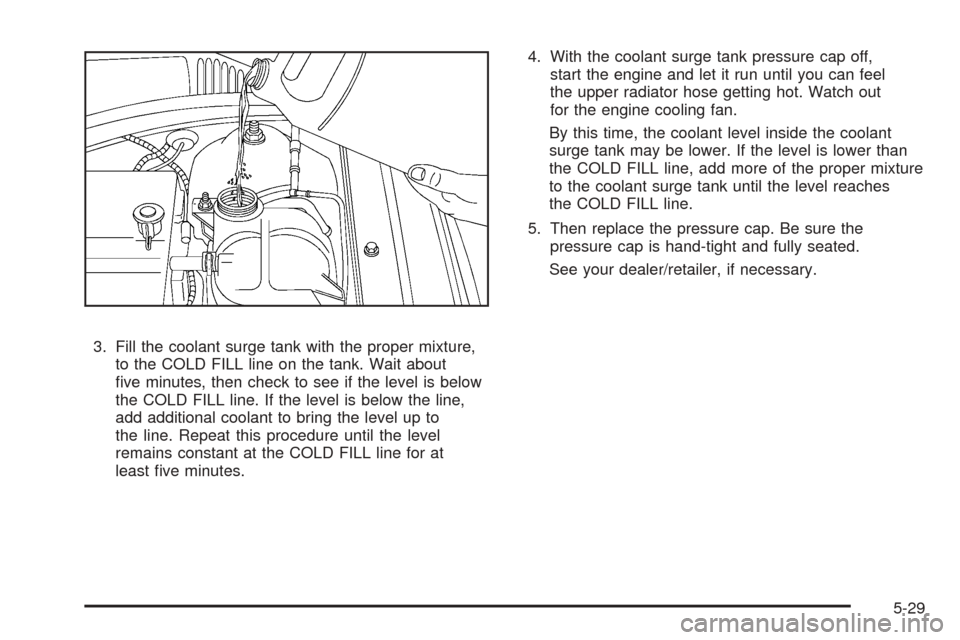
3. Fill the coolant surge tank with the proper mixture,
to the COLD FILL line on the tank. Wait about
�ve minutes, then check to see if the level is below
the COLD FILL line. If the level is below the line,
add additional coolant to bring the level up to
the line. Repeat this procedure until the level
remains constant at the COLD FILL line for at
least �ve minutes.4. With the coolant surge tank pressure cap off,
start the engine and let it run until you can feel
the upper radiator hose getting hot. Watch out
for the engine cooling fan.
By this time, the coolant level inside the coolant
surge tank may be lower. If the level is lower than
the COLD FILL line, add more of the proper mixture
to the coolant surge tank until the level reaches
the COLD FILL line.
5. Then replace the pressure cap. Be sure the
pressure cap is hand-tight and fully seated.
See your dealer/retailer, if necessary.
5-29
Page 268 of 402
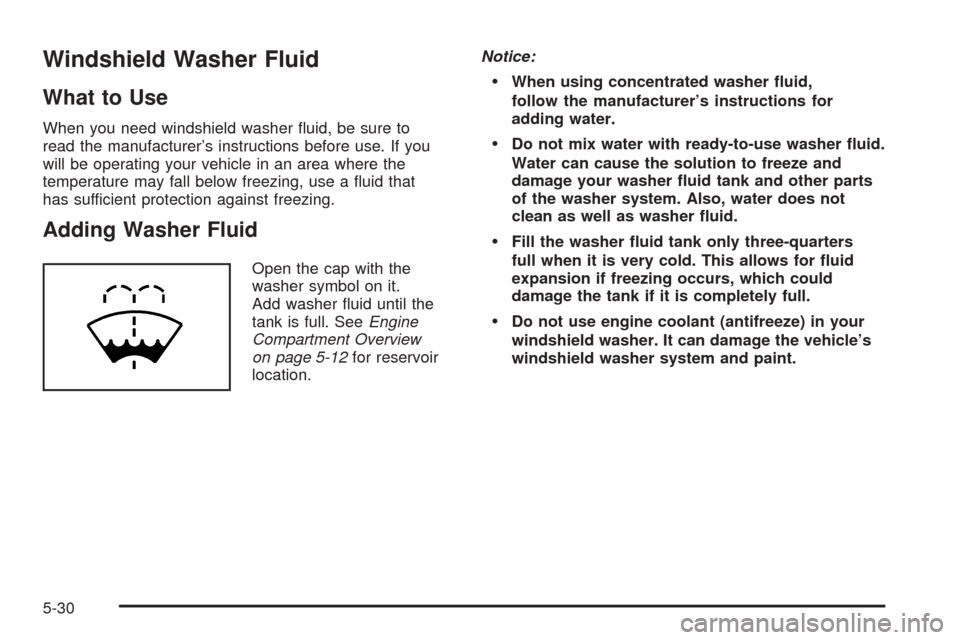
Windshield Washer Fluid
What to Use
When you need windshield washer �uid, be sure to
read the manufacturer’s instructions before use. If you
will be operating your vehicle in an area where the
temperature may fall below freezing, use a �uid that
has sufficient protection against freezing.
Adding Washer Fluid
Open the cap with the
washer symbol on it.
Add washer �uid until the
tank is full. SeeEngine
Compartment Overview
on page 5-12for reservoir
location.Notice:
When using concentrated washer �uid,
follow the manufacturer’s instructions for
adding water.
Do not mix water with ready-to-use washer �uid.
Water can cause the solution to freeze and
damage your washer �uid tank and other parts
of the washer system. Also, water does not
clean as well as washer �uid.
Fill the washer �uid tank only three-quarters
full when it is very cold. This allows for �uid
expansion if freezing occurs, which could
damage the tank if it is completely full.
Do not use engine coolant (antifreeze) in your
windshield washer. It can damage the vehicle’s
windshield washer system and paint.
5-30
Page 269 of 402
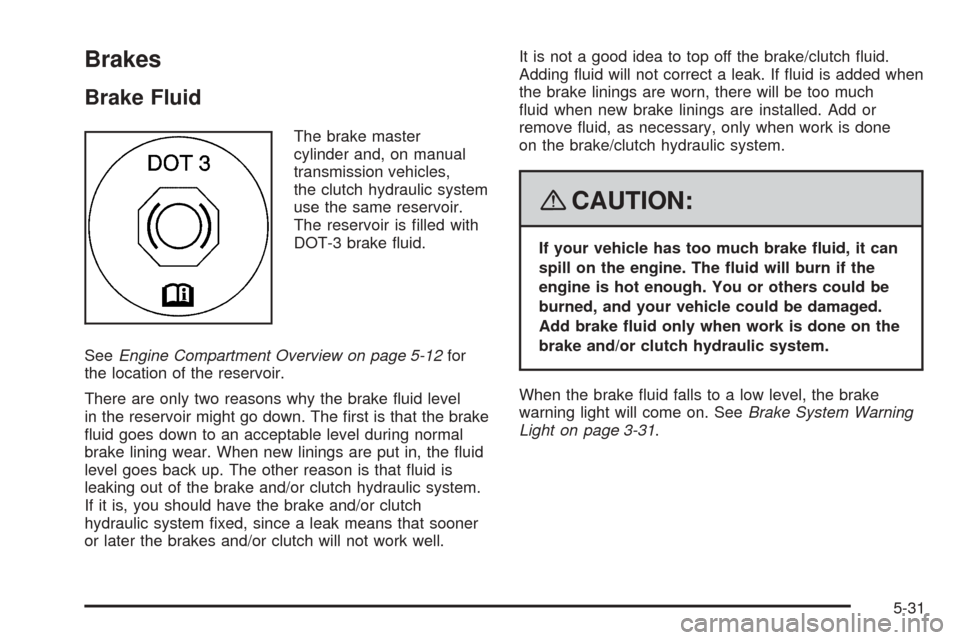
Brakes
Brake Fluid
The brake master
cylinder and, on manual
transmission vehicles,
the clutch hydraulic system
use the same reservoir.
The reservoir is �lled with
DOT-3 brake �uid.
SeeEngine Compartment Overview on page 5-12for
the location of the reservoir.
There are only two reasons why the brake �uid level
in the reservoir might go down. The �rst is that the brake
�uid goes down to an acceptable level during normal
brake lining wear. When new linings are put in, the �uid
level goes back up. The other reason is that �uid is
leaking out of the brake and/or clutch hydraulic system.
If it is, you should have the brake and/or clutch
hydraulic system �xed, since a leak means that sooner
or later the brakes and/or clutch will not work well.It is not a good idea to top off the brake/clutch �uid.
Adding �uid will not correct a leak. If �uid is added when
the brake linings are worn, there will be too much
�uid when new brake linings are installed. Add or
remove �uid, as necessary, only when work is done
on the brake/clutch hydraulic system.
{CAUTION:
If your vehicle has too much brake �uid, it can
spill on the engine. The �uid will burn if the
engine is hot enough. You or others could be
burned, and your vehicle could be damaged.
Add brake �uid only when work is done on the
brake and/or clutch hydraulic system.
When the brake �uid falls to a low level, the brake
warning light will come on. SeeBrake System Warning
Light on page 3-31.
5-31
Page 270 of 402
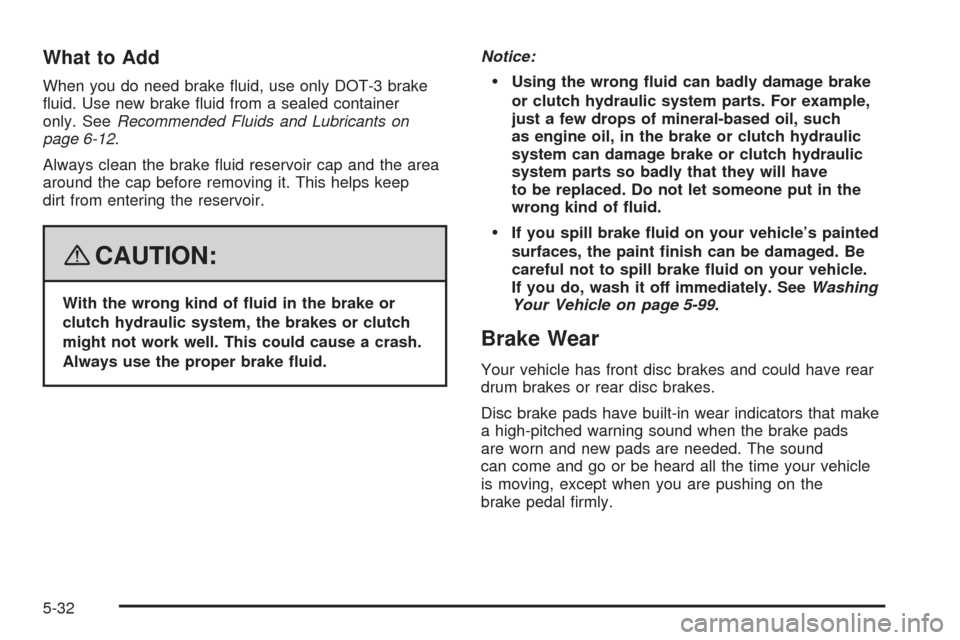
What to Add
When you do need brake �uid, use only DOT-3 brake
�uid. Use new brake �uid from a sealed container
only. SeeRecommended Fluids and Lubricants on
page 6-12.
Always clean the brake �uid reservoir cap and the area
around the cap before removing it. This helps keep
dirt from entering the reservoir.
{CAUTION:
With the wrong kind of �uid in the brake or
clutch hydraulic system, the brakes or clutch
might not work well. This could cause a crash.
Always use the proper brake �uid.Notice:
Using the wrong �uid can badly damage brake
or clutch hydraulic system parts. For example,
just a few drops of mineral-based oil, such
as engine oil, in the brake or clutch hydraulic
system can damage brake or clutch hydraulic
system parts so badly that they will have
to be replaced. Do not let someone put in the
wrong kind of �uid.
If you spill brake �uid on your vehicle’s painted
surfaces, the paint �nish can be damaged. Be
careful not to spill brake �uid on your vehicle.
If you do, wash it off immediately. SeeWashing
Your Vehicle on page 5-99.
Brake Wear
Your vehicle has front disc brakes and could have rear
drum brakes or rear disc brakes.
Disc brake pads have built-in wear indicators that make
a high-pitched warning sound when the brake pads
are worn and new pads are needed. The sound
can come and go or be heard all the time your vehicle
is moving, except when you are pushing on the
brake pedal �rmly.
5-32